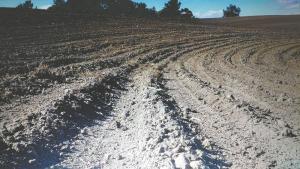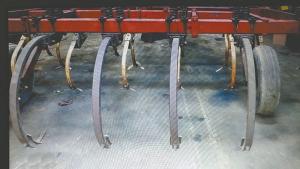2017 - Volume #41, Issue #3, Page #23
[ Sample Stories From This Issue | List of All Stories In This Issue | Print this story
| Read this issue]
He Says New Tillage Methods Improve Plant Growth
 |
 |
Now he’s blending 2 tillage concepts, a primary method he calls “Reverse Tillage” and a secondary method called “Track Tillage”. “Reverse Tillage” blends old crop residue into the soil using a disk rather than just burying it. Track Tillage deep-tills wide spaced trenches below the depth commonly run by a field cultivator. Forde says the trenches provide a place for heavy rainfall to soak into the soil, which helps establish a deep plant root system.
Forde says he modified a Bush Hog chisel plow to create his “Track Tillage” implement. “I started by mounting 9 chisel plow shanks on the back beam exactly 20 in. apart. Then I added 2 rows of CIH field cultivator shanks on beams in front so they lined up exactly with those on the rear. The implement gives me 9 rows with 3 shovels each, digging progressively deeper from front to back.”
Forde says as the implement goes through the field, soil is loosened and lifted into 12-in. high ridges between the shanks. The soil in the ridges warms up quickly and allows seed to be placed in a warm and moist environment for quick germination after just one pass with the field cultivator right ahead of the planter. Says Forde, “It’s a method that allows both organic and conventional farmers to work and plant their ground sooner in the spring. The planter row units easily press down the soil in the row area into an ideal seedbed, leaving the soil in between the rows course, porous and fluffy in miniature ridges about 4 in. tall. The loose soil also discourages early weed growth. The ridges act like miniature terraces to absorb moisture, even heavy rainfall, and allow it to soak into the subsoil rather than quickly running off.”
Forde says using the Track Tillage method in conjunction with Reverse Tillage helps eliminate runoff to control water loss and erosion. Rotary hoeing or tine weeding further levels the soil, helping cover up any weeds attempting to grow in the row area.
In addition to farming, Forde sells Flow-Shields, bolt-on metal plates that mount on shanks of row crop cultivators. Soil dug up by the cultivator shanks hits the shields, which break up clumps and divert the soil directly into the rows near the base of the growing crops, knocking down and covering up smaller stemmed weeds and grasses growing between crops. “Flow-Shields let you drive faster while cultivating and do a much better job,” says Forde.
Contact: FARM SHOW Followup, Curt Forde, Profit Organics, P.O. Box 141, Viroqua, Wis. 54665 (ph 608 606-0810; www.profitorganics.com).

Click here to download page story appeared in.

Click here to read entire issue
To read the rest of this story, download this issue below or click here to register with your account number.




